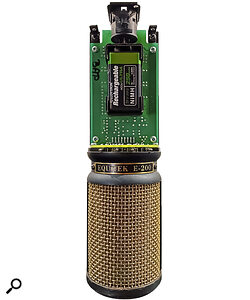 The Equitek E‑200 capacitor mic uses (and charges) two rechargeable 9V batteries as a power reservoir that makes more current available for its built‑in amps than is available over standard 48V phantom power. It’s an old mic and though NiCad batteries were originally specified, NiMH types will work just fine.I have a CAD Equitek mic that I bought second hand a while back, and I love it. It’s the multi‑pattern E‑200 one, and I’ve been using it happily for several years. Recently it stopped working properly, becoming increasingly distorted shortly after powering on. Since it uses phantom power, I hadn’t realised until I downloaded the manual that it also needs internal batteries to work properly! It’s an old mic, and the manual says I should put rechargeable NiCad batteries in there. But these were banned here in the UK several years ago [indeed, they’re now heavily restricted in many territories — Ed.], and I can’t find them anywhere! What should I put in the mic? Is it a write-off, or is it safe to use a different type of battery?
The Equitek E‑200 capacitor mic uses (and charges) two rechargeable 9V batteries as a power reservoir that makes more current available for its built‑in amps than is available over standard 48V phantom power. It’s an old mic and though NiCad batteries were originally specified, NiMH types will work just fine.I have a CAD Equitek mic that I bought second hand a while back, and I love it. It’s the multi‑pattern E‑200 one, and I’ve been using it happily for several years. Recently it stopped working properly, becoming increasingly distorted shortly after powering on. Since it uses phantom power, I hadn’t realised until I downloaded the manual that it also needs internal batteries to work properly! It’s an old mic, and the manual says I should put rechargeable NiCad batteries in there. But these were banned here in the UK several years ago [indeed, they’re now heavily restricted in many territories — Ed.], and I can’t find them anywhere! What should I put in the mic? Is it a write-off, or is it safe to use a different type of battery?
James Thompson
SOS Reviews Editor Matt Houghton replies: The short answer is that you can safely put rechargeable NiMH batteries in your mic. It will work just fine. But there’s a slightly longer explanation that might give you reassurance and stop some head‑scratching by other E‑200 owners!
Like you, I have an Equitek E‑200 that I bought used. I can definitely appreciate why this mic appeals to you, and certainly wouldn’t want to write it off! In the cardioid mode, as well as conveying the usual detail you get from a capacitor mic, I find that this one exhibits a really smooth and classy character that makes it great for my own vocals. It’s something that I’ve always put down to the fact that there’s not the significant top‑end lift you find on some vocal mics, and a dip in the response, centred around 6‑7 kHz, seems to tame harshness. That, in turn, tends to make dynamics processing more forgiving, and I find this mic can be really handy if I want to track vocals through a hardware compressor. It might not be the perfect match for every voice, but for some it sounds great.
Anyway, back to the question. Earlier this year, my mic also started to exhibit the sort of problems you describe, and I tracked this down to failing batteries. The date printed on those batteries indicated that they’d been in my mic since at least the early 2000s — over two decades! — and this makes me think that quite a few unsuspecting ‘second owners’ could be running into this issue around now, if they haven’t done so already.
As you’ve probably already gleaned, the mic employs a pair of rechargeable 9V batteries to supplement the phantom power supply, a sophisticated arrangement that makes more current available for its internal amplifiers. When not in use, the mic has internal circuitry, powered by phantom power, to trickle‑charge those batteries. The manual specifies NiCad (nickel‑cadmium) batteries and, like you, I discovered that these are simply not available to buy today, due to 2016 legislation restricting the use of cadmium in the EU and UK.
I can definitely appreciate why this mic appeals to you, and certainly wouldn’t want to write it off!
A little digging revealed that the more modern NiMH, or nickel‑metal hydride, batteries are available in the same physical form factor, and that these can often be simple drop‑in replacements for NiCad ones. But I also learned that while you can keep trickle‑charging NiCad batteries when they’re fully charged, that’s usually not the case for NiMH ones. They are more ‘fussy’ about the charging circuitry and can, if overcharged, overheat.
Not knowing the details of the mic’s charging circuitry, and fearing the worst, I emailed CAD’s customer support for advice. They confirmed (almost instantly — great support for a nearly 30‑year‑old product!) that the Equitek E‑200’s trickle‑charging circuitry is compatible with rechargeable NiMH batteries, and that these are, in fact, preferred to NiCad ones. So I bought and charged a couple, and popped them inside. And my mic has performed just as well as it always did ever since.
